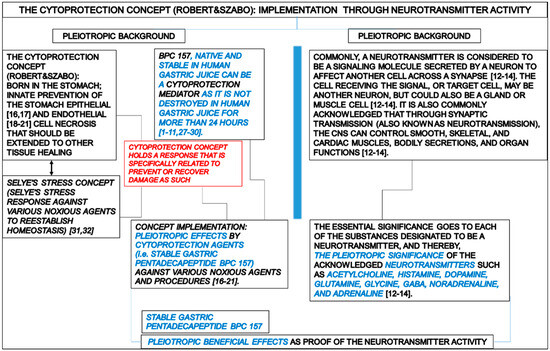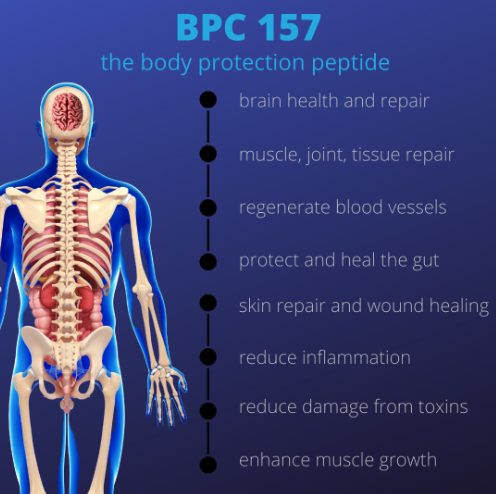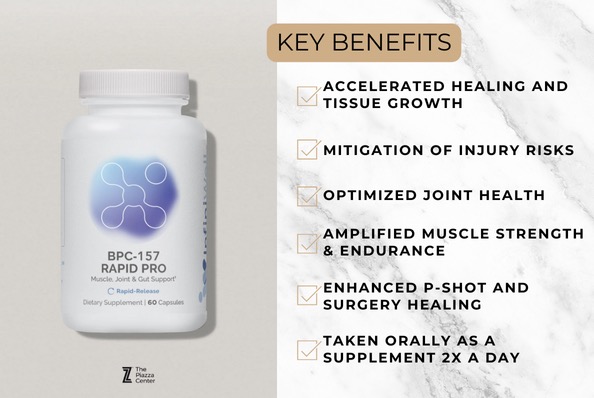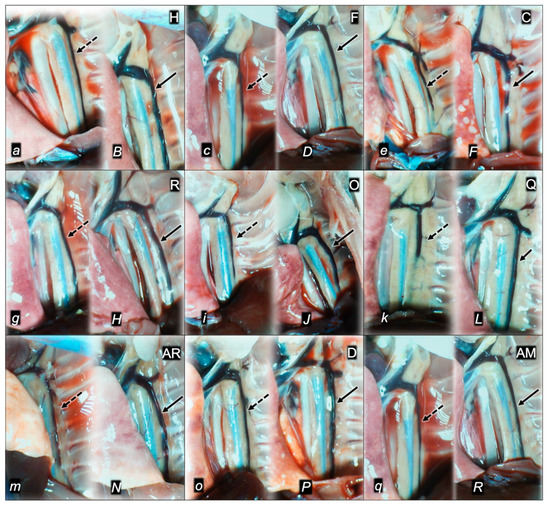Unveiling BPC 157: The Future of Holistic Healing
Imagine a molecule that promises a cascade of positive effects across multiple systems in your body. That’s BPC 157—a stable gastric pentadecapeptide capturing the interest of the medical community for its multifaceted activities. But what exactly makes BPC 157 so special?
First identified in human gastric juices, BPC 157 is unique due to its stability in the harsh environment of the stomach. This resilience allows it to function effectively without being broken down, making it a prime candidate for therapeutic applications, particularly in cytoprotection and tissue healing. In simpler terms, BPC 157 acts like a guardian, protecting cells and tissues from damage and promoting healing processes.

Image source: Source
The journey of BPC 157 from the confines of the stomach to the spotlight of medical research began decades ago. Researchers were intrigued by its potential to enhance tissue repair, crucial for recovering from injuries or surgeries. This potential has been underscored by numerous studies highlighting its broad therapeutic spectrum, making it a versatile tool in regenerative medicine. The peptide’s ability to interact with neurotransmitters further adds to its allure, suggesting it could play a role in modulating mood and mental health.

Image source: Source
In today’s rapidly evolving medical landscape, BPC 157 offers a glimpse into the future of holistic healing. Its broad range of benefits, from aiding in tissue repair to potentially influencing neurotransmitter activities, opens doors to new therapeutic strategies that address multiple facets of health simultaneously. This ongoing relevance keeps it at the forefront of scientific inquiry, as researchers continue to explore its full potential and new applications.

Image source: Source
In essence, BPC 157 is more than just a peptide; it’s a testament to the wonders of natural compounds and their potential to revolutionize healing. As you navigate the complex landscape of health and wellness, knowing about BPC 157 could be your key to understanding the future of comprehensive care. Some of the most promising solutions might just be hiding in plain sight, waiting to be discovered like BPC 157.
Unraveling How BPC 157 Works
BPC 157, a peptide known for its remarkable stability, can survive the harsh environment of the stomach to interact with various bodily systems. It plays a significant role in maintaining and repairing communication pathways, especially those involving neurotransmitters. By stabilizing these pathways, BPC 157 helps prevent disruptions that could lead to issues such as mood disorders or impaired healing (PubMed).

Image source: Source
This peptide is particularly noted for its ability to activate receptors like VGEF (Vascular Endothelial Growth Factor) and growth hormone receptors. These receptors are crucial for promoting tissue repair and angiogenesis, which is the formation of new blood vessels necessary for delivering nutrients and oxygen to repair sites (PMC). Such activation initiates a cascade of healing processes, underpinning BPC 157’s potential in regenerative medicine.
BPC 157 also exhibits a cytoprotective effect, safeguarding cells from damage. This protective role is vital in stabilizing neurotransmitter systems, ensuring clear and efficient communication within the body. This function is essential for preventing misfires in these systems that might lead to significant health issues.

Image source: Source
Overall, BPC 157 is a versatile peptide that fine-tunes the body’s internal communication and repair mechanisms. As research progresses, its potential in enhancing health and healing continues to be an exciting area of exploration.
The Impact of BPC 157 on Neurotransmitters
BPC 157, a stable gastric pentadecapeptide, is emerging as a potential influencer of key neurotransmitter systems, notably dopamine and serotonin, which play crucial roles in mood regulation and mental health. Recent studies highlight the peptide’s ability to modulate these neurotransmitters, offering promising therapeutic applications for mood disorders.

Image source: Source
BPC 157 acts as a mediator in the brain’s communication networks, addressing receptor disruptions and channel dysfunctions to restore balance. This modulation can be particularly beneficial for individuals struggling with mood imbalances, as it may help improve mental health outcomes by enhancing the efficiency of neurotransmitter pathways.
In today’s context of rising mental health challenges, understanding and utilizing compounds like BPC 157 could be transformative. Ongoing research continues to reveal the peptide’s potential in supporting neurotransmitter health, which could lead to new treatments and improved quality of life for many.
The journey of BPC 157 from being recognized for its healing properties to its potential in neuropsychiatric therapies underscores its versatile role in health and healing. As research progresses, the future of BPC 157 in mental health applications looks promising.
Neuroprotective Wonders of BPC 157
Imagine a tiny peptide offering a shield for your nervous system, much like a knight guarding a kingdom. BPC 157, a stable gastric pentadecapeptide, is emerging as a potential hero in the realm of neuroprotection. Its ability to guard against nerve damage and support neurological health presents exciting possibilities for treating various nerve-related conditions and disorders.

Image source: Source
In the complex world of neuroscience, BPC 157 stands out for its protective effects against a range of encephalopathies—conditions where the brain suffers damage or disease. This peptide has shown promise in experimental settings, suggesting it might help in cases of traumatic brain injuries and other neurological challenges. But how does it work its magic? The answer lies in its interaction with neurotransmitter pathways. By modulating key neurotransmitters like dopamine and serotonin, BPC 157 helps maintain the delicate balance necessary for optimal brain function. This modulation not only protects against damage but also enhances recovery and repair processes within the nervous system, according to a study by researchers.
For those grappling with neurological disorders, the potential of BPC 157 points to a future where treatment options could be more effective and less invasive. While traditional therapies focus on managing symptoms, BPC 157 could offer a means to address the underlying damage or dysfunction. The peptide’s ability to interact with neurotransmitter systems might indeed open new therapeutic avenues, offering hope to those affected by these challenging conditions, as highlighted in findings published in Gut and Liver.
As research continues to uncover the depths of BPC 157’s neuroprotective capabilities, the medical community remains optimistic about its potential applications. Although we’re still in the early stages of understanding its full impact, current findings suggest that BPC 157 might play a significant role in neurological healthcare, bringing us closer to effective solutions for protecting and healing the brain.
Clinical Insights and Safety Assessment
In the realm of clinical research, BPC 157 presents a compelling case with its remarkable safety record and therapeutic potential. You might be wondering, how safe is BPC 157, and what does the clinical evidence say? Let’s dive into the findings from various studies and trials.

Image source: Source
First and foremost, the safety profile of BPC 157 has been extensively evaluated. In multiple clinical trials, BPC 157 has demonstrated a lack of toxicity, even at varied dosage levels. Notably, studies have shown that there is no observed lethal dose, highlighting its potential for safe human use. This makes BPC 157 a promising candidate in contrast to many other compounds where toxicity can be a significant concern.
When it comes to its efficacy, BPC 157 has undergone Phase II trials for conditions such as ulcerative colitis. These trials have yielded positive results, suggesting that BPC 157 could play a role in managing such inflammatory conditions effectively. What’s particularly fascinating is the dosage range in which BPC 157 operates. It has been found effective in the microgram to nanogram range, allowing for minimal dosages through various administration routes, including oral consumption.
Given these insights, BPC 157 holds a unique position within the therapeutic landscape. It offers a combination of safety and efficacy that is rare among therapeutic peptides. However, as with any medical treatment, ongoing research is crucial to confirm these findings across broader populations and conditions.
Therapeutic Horizons for BPC 157
BPC 157 is emerging as a versatile peptide with potential applications extending into several therapeutic areas beyond its initial focus on gastric health. Its remarkable ability to protect and heal tissues presents exciting possibilities in mental health, inflammation, and nerve injuries.

Image source: Source
Mental Health
Research is investigating BPC 157’s role in modulating neurotransmitter systems crucial for mood regulation. This modulation could influence serotonin and dopamine pathways, offering new treatment avenues for mood disorders such as depression and anxiety. According to a study in the Gut and Liver Journal, BPC 157’s influence on these neurotransmitters holds promise for mental health therapies.
Inflammation
Inflammation is a common factor in many chronic conditions, including arthritis and heart disease. BPC 157’s cytoprotective properties could reduce inflammation and promote healing, potentially accelerating recovery and improving outcomes in inflammatory conditions.
Nerve Injuries
One of the most promising areas of BPC 157 research is its impact on nerve injuries. Studies have shown that it may aid in regenerating nerve tissues and restoring function in models of spinal cord injury. As noted in research published by Biomed Central, this peptide’s ability to promote healing presents significant potential for improving the quality of life for those with nerve-related damage.
As research progresses, the therapeutic horizons for BPC 157 continue to expand. While current findings are promising, further studies are critical to fully understanding its potential applications and ensuring its safe and effective use beyond gastric health. The future of BPC 157 in medical research holds the promise of a new era in healing and recovery.
Challenges and Ethical Considerations
As with any promising new therapy, BPC 157 faces challenges and ethical considerations. One of the main hurdles is navigating the complex regulatory landscape. BPC 157 is not currently approved for human clinical use, meaning it’s not legally available as a treatment in many regions. This lack of approval raises concerns about its safety and efficacy when used outside controlled research settings. According to a report by USADA, the peptide’s regulatory status underscores the need for caution.

Image source: Source
Imagine you’re a scientist on the verge of a groundbreaking discovery, only to find that regulatory frameworks make it incredibly challenging to bring your innovation to the public. This situation mirrors the journey of BPC 157. Although the peptide shows promise in various preclinical studies, transitioning from the lab to clinical practice involves rigorous testing to meet the standards set by governing bodies like the FDA. These processes ensure that new medications are both safe and effective.
Ethical concerns also surround BPC 157’s use, particularly the potential for misuse in less regulated markets. The peptide’s availability through online marketplaces raises questions about its quality and legality, which can lead to unsafe use or unintended side effects. The dangers of unregulated use highlight the need for caution.
The ethical dilemma extends to how BPC 157 is marketed and understood by the public. Without comprehensive clinical data, claims about its benefits can be misleading, potentially leading individuals to self-administer the peptide without adequate medical supervision. This situation emphasizes the need for transparent communication and ethical marketing practices that prioritize patient safety over profit.
Ultimately, the path forward for BPC 157 lies in continued research. Rigorous, peer-reviewed studies are essential to fully understand the peptide’s effects and establish a solid safety profile that regulatory agencies can rely on. Through this diligent process, BPC 157 may transition from a promising research subject to a safe and effective therapeutic option.
Future Research and Potential Developments
The landscape of medical research is ever-evolving, with BPC 157 poised to be a key focus of future studies. Its potential in neurological and regenerative medicine is particularly promising. Researchers are exploring how BPC 157 might be integrated into treatments for neurological disorders, given its ability to modulate neurotransmitter pathways such as serotonin and dopamine. This modulation suggests potential for developing new therapies for mood disorders and other mental health conditions, as highlighted in a study by the Gut and Liver Journal.

Image source: Source
In regenerative medicine, BPC 157’s role in tissue repair and healing processes is under investigation. Studies suggest significant potential for improving recovery outcomes in spinal cord injuries, with notable results in animal models, according to Biomed Central. The future may see BPC 157 being used in clinics to aid in the healing of severe injuries, effectively bridging the gap between acute treatment and long-term recovery.
Looking ahead, rigorous research is essential to fully understand BPC 157’s interactions with neurotransmitter systems and its long-term effects on human health. The path forward involves not just exploring these questions but ensuring developments are supported by robust clinical evidence.
As the journey of BPC 157 in medical science continues, its potential remains significant. Continued research and innovation could see this peptide playing a pivotal role in future therapeutic landscapes, transforming how we approach health and healing. Staying informed on the latest findings and advancements will be key to understanding the scope of its capabilities.
The Future Potential of BPC 157 in Health and Healing
Imagine a world where a single compound transforms healing across a spectrum of conditions. That’s the potential of BPC 157, a stable gastric pentadecapeptide that has captivated the scientific community with its broad applications. Its pleiotropic nature means it can affect multiple systems in the body, offering a holistic approach to healing.
One of the most exciting aspects of BPC 157 is its interaction with neurotransmitter systems, such as those involving dopamine and serotonin. These interactions suggest it could be revolutionary for mental health, providing new avenues for treating mood disorders and enhancing overall neurological health. This potential is supported by studies highlighting its role in counteracting receptor disturbances and channel dysfunctions—a promising sign for future therapeutic applications (source).
As research continues, BPC 157’s ability to support cell protection, enhance healing, and address complex neurological issues underscores its versatility as a therapeutic agent. While challenges remain, particularly around regulatory approval and ethical considerations, BPC 157 is poised to become a cornerstone of innovative healthcare solutions. The journey ahead is promising, with the potential to revolutionize treatment and healing approaches in the coming years (source).
